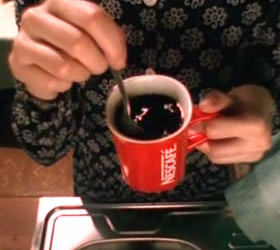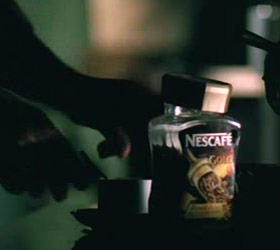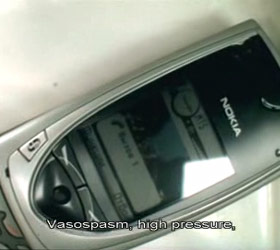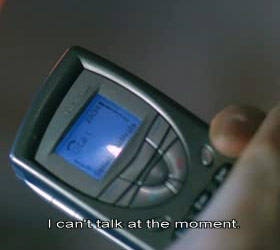I remember some years back flipping through Men’s Health —a magazine to which, at the time, I was subscribed despite a poor diet, lifestyle, and a severe disinclination to do anything about either— spotting on the back cover a full-page advertisement for prostate cancer.
Not that they were selling me prostate cancer, just trying a raise awareness. More Australian men die every year of prostate cancer than women of breast cancer, yet it receives only one tenth the funding (source). People like breasts. I like breasts. Nobody dislikes breasts. You need look no further than the massive media coverage of Kylie Minogue’s breast cancer scare to see a global preference for breasts in action, but nobody really likes the prostate. It’s like the gall bladder, or the pancreas… nobody gives a damn until something goes wrong.
And who can blame them? The prostate isn’t exactly glamourous, but somebody has taken up its cause. For the last two years, the Prostate Cancer Foundation of Australia has been organizing Movember: a national prostate cancer awareness-building and fund-raising exercise. Blokes sign up, they coerce their family and coworkers to donate money, and they spend the entire month of November cultivating a luscious moustache for the cause.
To be honest I didn’t know until three days ago that it was a charity event —I thought Movember was just a goof that an unusual number of university students participated in— but it turns out that it’s a great opportunity to grow a ridiculous moustache that no girlfriend, wife, or employer could possibly object to: it’s for a good cause, after all.
For those with itchy credit cards and a desire to encourage this kind of thing, head on over to the Movember Sponsorship page and donate some funds (my rego number is 1459), or sign up to grow one yourself. You know you want to.
Posted by Chris Clark on November 1, 2005 at 3:52 PM
I’ve only really taken to podcasting very recently. Despite having Richard yammer on and on about how fantastic the medium is (which seems to be working for him, he’s had great success with the Gadget Show and is currently finishing up another book on the phenomenon) I didn’t embrace it early on.
My best excuse for those laggardly ways was the ownership of an iPod Shuffle —a device that (rightly or wrongly) doesn’t sync podcasts itself— but my switch to the Nano brought me up to speed. iTunes and the Nano handle podcasting very gracefully, and with the explosion of quality content lately there’s no shortage of good stuff to listen to while I vacuum the floor on a Friday afternoon.
So why the unhappy face? Well, despite its many positives, iTunes misses a few beats with its implementation of podcast aggregation. My main concern: if it ain’t a subscribed feed, it ain’t in the Podcast section of the source list.
Here’s the thing: I don’t want to be subscribed to every podcast in the world, so when something turns up out of the blue (like that interview with Bill Watterson’s mother, or that CIO Magazine interview with Joel Spolsky) I don’t necessarily want to subscribe… I just want to listen to the one episode and be done with it. (Quick aside: that Spolsky interview isn’t even part of a feed, so listening to the one standalone episode is your only option). Unfortunately, iTunes doesn’t handle these standalones so gracefully.
Any audio file you add to iTunes that didn’t come by way of a subscription doesn’t show up in the Podcast department. Drag it, drop it, change the genre to Podcast, copy it into the ~/Music/iTunes/iTunes Music/Podcasts directory, do whatever you like… no dice. The knock-on effect being that when the new file gets synced to your iPod, it doesn’t end up in the Podcasts section there either… nor does it get a spiffy played/unplayed indicator. Sad.
This is Apple’s problem, clearly, and something that needs fixing (along with column sorting, keyboard navigation, and easier non-iTMS subscription)… but until that day comes there is a solution: a solution that requires two middlemen and is sadly very hacky, but a solution nonetheless. The gist? Bookmark the audio or video file you want using del.icio.us, FeedBurn the del.icio.us-generated RSS feed to podcast-enable it (del.icio.us feeds linking to media files don’t issue them with enclosures… so they don’t cast as expected), subscribe to that burned feed in iTunes, et voilà!
It may be ugly, and it may require you to sign up for two services you otherwise have no use for (hey, I ain’t big on bookmarking and I ain’t big on social software), but it does the job. For unsubscribables like the CIO Magazine interview above, it’s your only choice. In cases like the Watterson interview or other one-offs, it allows you to aggregate something without committing to a whole feed of other (potentially interesting, potentially not) content. Hell, it even allows you to aggregate things that have fallen out of a podcast’s feed by virtue of being too old! Definitely worth a try, if only because it keeps things neater than they would otherwise be.
Posted by Chris Clark on November 6, 2005 at 9:06 PM
So I’ve been listening to a lot of podcasts lately —blah blah blah, you’ve heard this, right?— and in the gigabytes of crap I’ve accrued, a couple of shows have stood out for reasons they doubtless wish they hadn’t. This is the story of one such show.
It’s called Designing for Usability —a feed I discovered as I searched the iTunes directory for anything both interesting and software-related— and it’s produced by Classic System Solutions. They’re a design/usability consultancy, this is their usability podcast; sounds promising, non? The QA Podcast seems to be working for QA Labs, and basically anybody with knowledge to share and a consultancy to plug is doing so by podcast these days, so what could go wrong?
Well, the thing that strikes you about Designing for Usability (if you subscribe) is that it doesn’t share knowledge so much as it emits a heavy funk; it’s a marketing ploy, and a lousy one at that. Red flags raised:
- It’s a podcast consisting of one show posted mid-August and not touched since.
- An acronym is employed to spell out the seven steps to S.U.C.C.E.S.S. (!)
- Cheesy customer testimonials.
- The word synergy.
- An execrable ‘host’ one expects to squeal “Gee willikers mister! This usamajility stuff sure sounds tough!” at any moment.
- Tortured dialogue (see above).
- A free newsletter.
- A 1-888 alpha-mnemonic phone number.
- Plenty of cheese.
And through all this you have to wonder why. Why would anybody sign off on this colossal misallocation of advertising dollars? What kind of customer does such a patently inauthentic marketing scheme hope to attract? The gullible kind? It’s an infomercial, plain and simple… and I don’t know anybody in the technology business that actually buys into that kind of marketing. Designing for Usability has become one of those sad cases where an attempt at marketing fails because the producers don’t see how tacky and cliché it is. Ronco spray-on usability indeed.
I don’t mean to bag on ClassicSys: there is some decent advice in there, and they might have first-class usability consultants, but there’s something to be said for a podcast that can make a grown man gag in under forty seconds. It took an iron will and buns of steel to sit through the remaining twenty-eight minutes, and whether ClassicSys really is as bogus as they sound or whether they’re just the victim of a bad advertising agency, it makes them look phony. Of all the images you want to project about your company, that isn’t one of them. Talk to Infinium Labs if you don’t believe me.
The funny part is, their chosen delivery format is the one leading the charge against this kind of old-media bullshit. The entire weblogging experience, of which podcasting is an extension, is about authenticity. About transparency. Airing 7 Steps to Successful User Interface Design on The Steak Knife Channel with a few guys in tweed jackets and bouffant hairpieces might actually work if the housewife set were in need of UI advice, but it just doesn’t fly here in hi-tech land. For god’s sake… remember your audience.
Posted by Chris Clark on November 10, 2005 at 6:18 PM
Wow. And I mean wow. A “profoundly disabled” woman is suing for wrongful life? [via digg]
Alexia Harriton, 24, is seeking compensation from the doctor who misdiagnosed rubella in the first trimester of her mother’s pregnancy, claiming Olga Harriton would have aborted her had she been aware of the potential birth defects arising from the illness.
Lawyers for the Sydney woman argued in Australia’s highest court Thursday that Dr. Paul Stephens is liable for the costs arising from a lifetime of medical treatment that Harriton needs to survive.
It isn’t the parents doing the suing, it’s the affected woman. The courts have so far rejected the claim on the basis that it’s ridiculous to weigh nonexistence against an impeded existence, but several questions spring immediately to mind:
- How is she even filing this suit? The article is a little short on details here, but one would assume that a person “born mentally retarded, spastic, deaf, and blind” would lack the mental acuity and communicative capacity to do so.
- I’m not trying to be crass here, but how does a fat wad of money from a malpractice suit resolve an “I wish I’d never been born” situation?
- Were the parents kidding around, naming a blind child Alexia? I mean, it’s fitting, in a pretty twisted way, but only in the way you’d name a child with intestinal hemorrhaging Melena.
- When do the lawsuits for children of poverty start being filed? Surely the doctors should’ve advised the parents that they were too poor to raise the child comfortably. At what point is one’s life “comfortable enough” that litigation isn’t the solution?
Kinda puts “RIAA sues children for file sharing” in perspective though, doesn’t it? A few bucks of lost income: successful court action. Lifetime of suffering: bubkes.
Regardless, I’m going to take my usual position when it comes to people being pissed about science’s failings: think about where you’d be without it, and thank your lucky stars you’ve even lived this long.
Posted by Chris Clark on November 15, 2005 at 12:19 PM
A few weeks ago my estranged brother was in town, so we figured we’d go see a movie. OK, so he’s not really estranged. He does live a really long way away, and I do only see him a couple times a year, but he doesn’t really qualify for the ‘estranged’ label. That said, it’s fun to put qualifiers in front of relations.
Take “my paternal grandmother” for instance, or “my biological father”. Think of add-ons like “by marriage” and “twice removed”… they bring joy to all around them. A qualified relation is a relation with some history; it’s a relationship with a story. Reminds me of that classic piece of Dave Hughes material:
I went to school down in Warrnambool, I lived down there for a lot of years with my Mum and her partner… who’s my Dad. I still like to refer to him as Mum’s partner though. Just cuts me off a bit, y’know? Makes it her choice, not mine.
So anyway: the brother was in town and I was somehow convinced to go see Night Watch, a Russian ‘fantasy horror’ flick that apparently did very well in its home country. This doesn’t really say much… Priscilla, Queen of the Desert did very well in its home country too. Suffice to say Night Watch suffers from Hollywooditis, but was in all an adequate film nonetheless.
Besides the “dynamic subtitles” I was told would add to the drama (proving once and for all that flashy, animated text is more difficult to read than its regular, static half-uncle) I was mostly kept amused by the product placement; or rather, “brand management”.
The Playstation is a fairly prominent prop in the film: Zavulon (apparent leader of the “Dark Others”) likes to rehearse his battles in a video game starring himself and his future opponent… playing through different strategies to assure victory when the real fight arrives. While I wait for Jack Thompson to pounce on this, you’ll note that the controller’s logos and graphics have been covered up, or outright removed.  No Sony trademarks appear on screen while Zavulon plays his game.
No Sony trademarks appear on screen while Zavulon plays his game.
I’m obviously not a well-rounded enough individual to understand how blanking out a few corporate logos reduces our ability to identify such an easily-recognizable products, but product placement has always been more a political arena than a legal one.
See, too, the iMac. The Apple logo on the back of the display (as well as the same on the front of the machine, shown in a later scene) is covered with a Post-It. A PowerBook in an even later scene sports a “City Light Company” (AKA the Night Watch) sticker over its glowing Apple logo.
The producers, clearly not having negotiated a pocket-lining agreement with Sony or Apple, don’t want to just give publicity away (nor do they want to endanger future negotiations with them or their competitors by giving them any “you did it for free last time!” ammunition), but this is pretty lame… with products like these, how can you really suppress the brand? Anyone can recognize a Playstation controller —with or without the logos— it’s a distinctive design, and all the stickers and Post-Its in the world aren’t going to change that.
Now consider the products whose advertising budgets did find their way into somebody’s bank account…
Wowsers. That shit looks like it was pulled from a glossy magazine. The red mug, the black coffee, the self-conscious tapping of spoon on cup. I’m glad they didn’t have a deal with either of the aforementioned electronics vendors, I might just choke on the branding if it were this front-and-center.
Nokia scored a similar deal, given that their hardware is used exclusively by all phone-toting characters, but it doesn’t seem as overwrought. Maybe because we’re used to seeing phones, and the script calls for the use of phones, and phones are inevitably branded by their manufacturer, and the Matrix prepared us for a lot of Nokia exposure… but it just doesn’t seem as obvious as the Nescafé bit.
Then again, maybe I’m wrong.
Posted by Chris Clark on November 28, 2005 at 11:06 PM


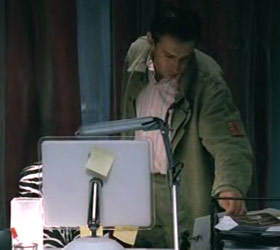
 No Sony trademarks appear on screen while Zavulon plays his game.
No Sony trademarks appear on screen while Zavulon plays his game.